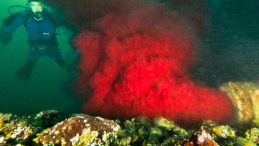Blood Water Tests Confirmed: Fish Plant Outfalls Contaminated
Both Brown’s Bay and Lions Gate plants discharging virus and bacteria
Vancouver: Environmental groups are applauding the B.C. government’s recent decision to conduct a review of fish processing plants, following revealing video of virus-laden bloodwater being discharged into the ocean.
After the video and initial lab results were released publicly, the fish farming industry said that discharge from fish processing plants was disinfected prior to release to the environment.
However, government tests confirmed the initial findings. Bloodwater from both plants tested was contaminated with piscine reovirus (PRV), a virus that is highly contagious to both wild and farmed fish. In addition, the waste showed extremely high levels of enterococcus, a bacterium normally found in sewage. Samples taken from both plants showed more than 60,000 units per 100 millilitres while the level considered safe for human recreation in water is less than 70 per 100 millilitres. The government’s findings also make it clear that the plants’ effluents were not being disinfected as originally claimed by the BC Salmon Farmers' Association and Brown’s Bay Packing Co. Ltd.
“The government’s own testing confirmed that the waste discharged from both Browns Bay and Lions Gate fish processing plants was loaded with PRV,” said Alexandra Morton of Raincoast Research Society. “Independent tests also confirmed that the virus was capable of being cultured in the lab, meaning it was alive and able to infect other fish. PRV is carried in the blood, where scientists believe it weakens fish, making them less able to feed, evade predators or make their way upstream to spawn.”
John Werring, Senior Science and Policy Advisor to the David Suzuki Foundation, observed that the levels of virus and bacteria shown on the lab reports are inconsistent with the claim by Brown’s Bay Packing that its effluent is disinfected. “Even today, Brown’s Bay’s website refers to ‘our disinfected effluent discharge process’ in the context of recent negative media reports,” Werring said. ”While the plant appears to be equipped with chlorination facilities, they were clearly either not in use or were ineffective when the sample sets were taken.”
“It is difficult to put the lab results into perspective, since we don’t know how high the levels of these harmful bacteria are after dilution in the waters of Brown’s Bay or near the plant in Tofino,” said Karen Wristen, Executive Director of Living Oceans Society. “Levels this high really require testing of the local waters on a priority basis to understand the risk to human health and the marine environment.”
It is presently unknown why the levels of enterococcus were so high in the processing plant waste. It is common practice to starve fish for several days before slaughter, so that their guts will be empty. A DFO webpage entitled “Thinking Out of the Box: Exploring Strategies to Reduce Sea Lice Infestations in Salmon Farms1” dated 2017-01-19 reports that DFO has been exploring since 2013 the use of beneficial bacteria added to feed to increase resistance to sea lice, but there is no publicly available information about the content of feeds currently in use. Samples taken from the well of a boat used to transport fish to Lions Gate tested positive for enterococcus as well, but the levels (690 units per 100 millilitres) were orders of magnitude lower than the levels at the plants.
“I have asked the Ministry of the Environment to look into the potential for danger to human health and the marine environment arising from this bloodwater,” said Morton. “However the most urgent concern is, now that government knows about this plume of PRV-infected bloodwater, are they going to allow another generation of Fraser River salmon to swim through it starting in a few weeks?”
-30-
Contact Information
John Werring, David Suzuki Foundation 604-306-0517
Alex Morton, Raincoast Research Society 250-974-7086
Karen Wristen, Living Oceans Society 604-788-5634
Background
Footnote 1: http://www.dfo-mpo.gc.ca/science/publications/article/2016/09-14-16-eng.html
Pacific Biological Station (DFO) narrative report: https://www2.gov.bc.ca/assets/gov/environment/research-monitoring-and-reporting/reporting/reporting-documents/environmental-enforcement-docs/fish-processing-compliance-audit/2017-12-18_dfo-csap_aquaculture_emergency_response.pdf

